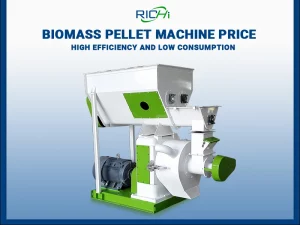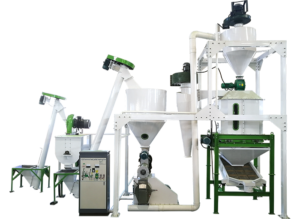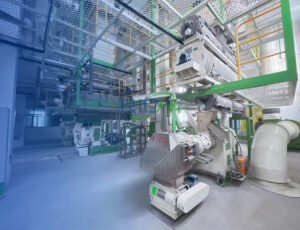
Alfalfa pellet machines have revolutionized the process of making alfalfa pellets, a valuable feed source for livestock. These machines are specifically designed to compress and shape loose alfalfa into compact pellets, making it easier to transport, store, and feed to animals.
In this article, we will delve into the various aspects of alfalfa pellet machines, including their benefits, key features to look for, how to choose the right machine, maintenance tips, common issues and how to troubleshoot them, safety precautions, comparing different models, and the future of these machines.

What is an Alfalfa Pellet Machine?
An alfalfa pellet machine is a specialized device that transforms loose alfalfa into compressed pellets.
The machine typically consists of a feeder, a conditioner, a pellet mill, and a cooler. The feeder ensures a consistent supply of alfalfa to the conditioner, where moisture is added to improve the pelletizing process. The conditioned alfalfa then enters the pellet mill, where it is compressed through the die holes to form pellets. Finally, the pellets are cooled to remove excess moisture and increase their durability.
Related post: https://richipelletizer.com/alfalfa-pellet-machine/
Benefits of Using an Alfalfa Pellet Machine
Using an alfalfa pellet machine offers numerous advantages.
- Firstly, it allows for the preservation of alfalfa nutrients. The pelletization process helps retain the nutritional value of alfalfa, ensuring that animals receive a well-balanced diet.
- Additionally, pellets are easier to handle, store, and transport compared to loose alfalfa, reducing wastage and labor requirements.
- Furthermore, alfalfa pellets have a longer shelf life than loose alfalfa. The compression process removes excess moisture, preventing spoilage and mold growth. This increases the availability of alfalfa feed throughout the year, even during times of scarcity.
- Moreover, alfalfa pellets provide a convenient and consistent feed source. The uniform size and shape of the pellets make it easier to measure and distribute feed accurately. This helps in maintaining animals’ health, preventing overeating or underfeeding.
Key Features to Look for in an Alfalfa Pellet Machine
When choosing an alfalfa pellet machine, several key features should be considered.
- Firstly, the machine’s capacity is important as it determines the amount of pellets that can be produced in a given time. The power of the machine also matters, as it affects the efficiency of the pelletizing process.
- The quality of the pellet die is crucial as it determines the durability and consistency of the pellets. Look for a machine with a durable die made from high-quality materials to ensure long-lasting performance. Additionally, the machine’s control system should be user-friendly and allow for easy adjustment of pellet size and density.
- Furthermore, consider the machine’s safety features, such as emergency stop buttons and overload protection. A reliable and reputable manufacturer is also important as it ensures the machine’s quality and provides support in case of any issues.
How to Choose the Right Alfalfa Pellet Machine for Your Needs
Choosing the right alfalfa pellet machine depends on several factors.
- Firstly, consider the scale of your operation. Small-scale farmers or hobbyists may opt for compact and portable machines, while larger operations may require industrial-grade pellet mills with higher capacities.
- Consider the power source available. Alfalfa pellet machines can be powered by electricity or diesel engines. Electric machines are more suitable for indoor use and require a stable power supply, while diesel-powered machines offer more flexibility and can be used in remote locations.
- Budgetary considerations are also important. Determine your budget and compare different models to find the best value for your money. It is recommended to invest in a pellet maker from a reputable manufacturer, even if it means a slightly higher initial cost, as it ensures better performance and durability in the long run.
Step-by-Step Guide: Using an Alfalfa Pellet Machine
Using an alfalfa pellet machine involves a series of steps.
- Firstly, ensure that the machine is properly set up and all safety precautions are followed.
- Then, add the loose alfalfa to the feeder, which will supply the conditioning chamber.
- Adjust the moisture level as per the manufacturer’s recommendations to achieve optimal pelletization.
- Once the conditioned alfalfa enters the pellet mill, monitor the temperature and adjust it if necessary. This helps in maintaining the quality and integrity of the pellets.
- Collect the freshly produced pellets from the pellet mill and transfer them to the cooler, where they will be cooled and dried to remove excess moisture.
- After the pellets have cooled down, they are ready for storage or immediate use as animal feed. Properly store the alfalfa pellets in a cool and dry location to maintain their quality and prevent spoilage.
Maintenance Tips for Your Alfalfa Pellet Machine
Regular maintenance is essential to ensure the efficient and prolonged operation of your alfalfa pellet machine.
- Clean the machine regularly to remove any debris or residue that may affect its performance.
- Lubricate the moving parts according to the manufacturer’s recommendations to prevent friction and wear.
- Inspect the die and rollers for any signs of damage or wear, as these components play a crucial role in pellet formation.
- Replace them when necessary to maintain the quality of the pellets.
- Additionally, check the electrical connections and wiring to ensure they are secure and functioning properly.
Common Issues with Alfalfa Pellet Machines and How to Troubleshoot
Despite their efficiency, alfalfa pellet machines may encounter some common issues.
- One such issue is blockage or clogging of the machine due to excessive moisture or foreign objects. To troubleshoot this, adjust the moisture level or remove any obstructions from the feed system.
- Another issue is uneven pellet quality or size. This can be caused by worn-out dies or improper adjustment of the machine settings. In such cases, replace the die or adjust the settings to achieve the desired pellet quality.
Safety Precautions When Operating an Alfalfa Pellet Machine
Operating an alfalfa pellet machine requires adherence to safety precautions. Always wear appropriate protective gear, such as gloves and safety goggles, to prevent injuries. Familiarize yourself with the machine’s operating manual and follow the recommended procedures.
Avoid reaching into the machine while it is in operation, and keep loose clothing, hair, and jewelry away from moving parts. Regularly inspect the machine for any potential hazards and address them promptly. In case of any malfunctions or abnormalities, stop the machine immediately and seek professional assistance.
Comparing Different Models of Alfalfa Pellet Machines
There are numerous models of alfalfa pellet machines available in the market, each with its own unique features and specifications. When comparing different models, consider factors such as capacity, power source, build quality, control system, safety features, and after-sales support.
Read customer reviews and seek recommendations from other users to get an idea of the performance and reliability of different machines. Compare prices and warranty periods to make an informed decision that suits your specific requirements.
The Future of Alfalfa Pellet Machines: Innovations and Trends
The future of alfalfa pellet machines looks promising, with ongoing innovations and trends in the industry.
- Manufacturers are focusing on developing more energy-efficient machines that reduce power consumption and environmental impact. Integration of advanced control systems and automation is also on the rise, allowing for increased precision and efficiency in the pelletizing process.
- Furthermore, there is a growing emphasis on sustainability in the agricultural sector, which is likely to drive the development of eco-friendly and renewable energy-powered pellet machines. Research and development efforts continue to optimize the pelletization process, resulting in improved pellet quality and nutritional value.
- Alfalfa pellet machines have revolutionized the way alfalfa is processed and utilized as animal feed. Their numerous benefits, such as nutrient preservation, ease of handling, and longer shelf life, make them an essential tool for farmers and livestock owners.
By considering the key features, choosing the right machine, and following proper maintenance and safety precautions, users can ensure the efficient and safe operation of their alfalfa pellet machine. With ongoing innovations and trends in the industry, the future of alfalfa pellet machines looks promising, with increased efficiency, sustainability, and improved pellet quality.






